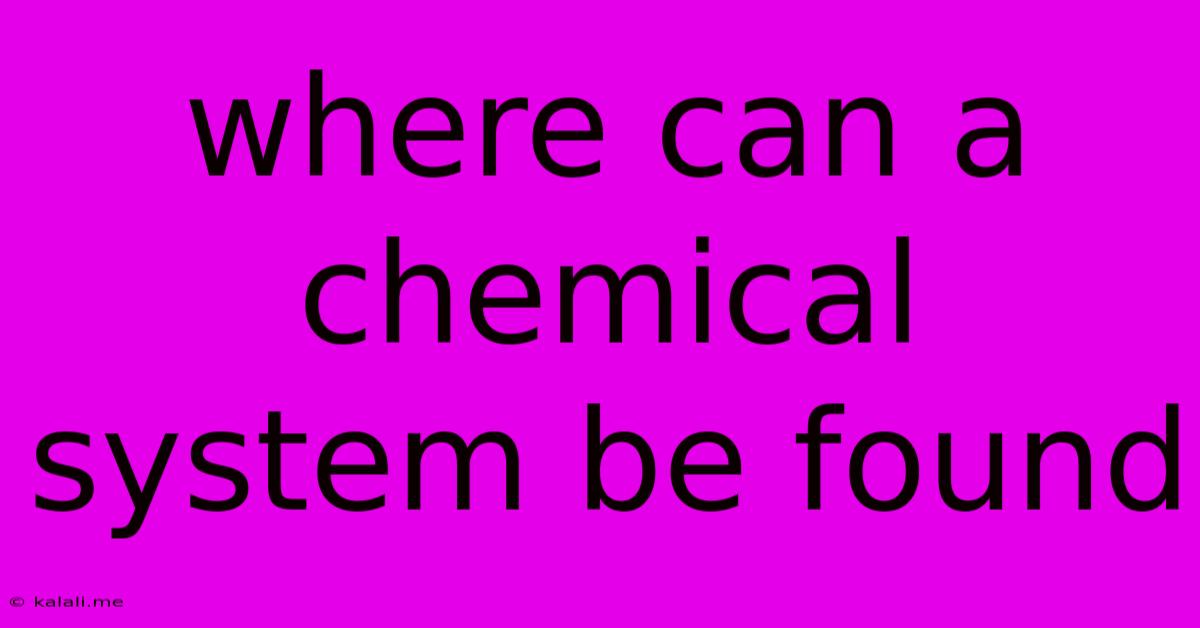Where Can A Chemical System Be Found
Kalali
Jun 07, 2025 · 3 min read

Table of Contents
Where Can a Chemical System Be Found? A Comprehensive Look
Chemical systems are everywhere; they're the fundamental building blocks of our universe. Understanding what constitutes a chemical system and where they exist is key to grasping the complexity of the world around us. This article explores the diverse locations and examples of chemical systems, from the microscopic to the macroscopic. We'll delve into various types and their significance, offering a comprehensive overview for both beginners and those seeking a deeper understanding.
Defining a Chemical System
Before exploring locations, let's define what a chemical system is. Simply put, a chemical system is a collection of matter undergoing or capable of undergoing a chemical change. This change involves the rearrangement of atoms and molecules, forming new substances with different properties. The system can be open, closed, or isolated, depending on the exchange of matter and energy with its surroundings. Understanding this distinction is crucial when analyzing chemical reactions and their outcomes.
Examples and Locations of Chemical Systems: From the Smallest to the Largest
Chemical systems aren't confined to a laboratory setting. They're ubiquitous, operating across different scales and environments:
1. Within Living Organisms:
- Cellular Processes: The most fundamental chemical systems are found within cells. Metabolic processes like respiration and photosynthesis are complex chemical reactions crucial for life. These systems involve intricate networks of enzymes, substrates, and products.
- Organ Systems: Expanding beyond the cellular level, organ systems like the digestive system or the circulatory system operate as larger chemical systems. Digestion, for instance, involves a cascade of chemical reactions breaking down food molecules.
- Ecosystems: Entire ecosystems are interconnected chemical systems. Nutrient cycles, such as the nitrogen cycle or carbon cycle, illustrate large-scale chemical transformations that sustain life.
2. In the Non-Living World:
- The Atmosphere: The atmosphere is a vast chemical system with various gases interacting through complex chemical processes. The formation of ozone, acid rain, and smog are examples of atmospheric chemical systems.
- The Oceans: Ocean water is a dynamic chemical system influenced by factors like salinity, temperature, and dissolved gases. Ocean acidification, a crucial environmental concern, arises from changes in this system.
- The Earth's Crust: Geological processes, such as weathering and mineral formation, involve chemical reactions that reshape the Earth's surface over geological timescales. These reactions are often slow but impactful.
- Industrial Processes: Human activities generate numerous chemical systems. Manufacturing processes, chemical plants, and refineries all involve controlled chemical reactions to produce various products.
3. In Everyday Objects:
- Food and Beverages: Food preparation and digestion are essentially chemical systems. Cooking changes the chemical structure of ingredients, while digestion breaks them down for absorption.
- Cleaning Products: Cleaning solutions rely on chemical reactions to remove dirt and stains. These systems involve various chemicals interacting to break down grime.
- Pharmaceuticals: Medicines are chemical compounds designed to interact with biological systems, triggering specific chemical reactions to treat illness.
Factors Influencing Chemical Systems
Several factors influence the behavior and outcomes of chemical systems:
- Temperature: Temperature affects reaction rates and equilibrium positions.
- Pressure: Pressure can alter the rate and direction of reactions, especially in gaseous systems.
- Concentration: The concentration of reactants and products significantly impacts reaction rates and equilibrium.
- Catalysts: Catalysts speed up reactions without being consumed themselves.
Conclusion
Chemical systems are integral to understanding the world. They operate across various scales, influencing everything from cellular processes to global climate patterns. By understanding these systems, we can better address challenges related to environmental sustainability, human health, and technological advancements. The examples provided represent a fraction of the diverse locations where chemical systems can be found, highlighting their profound influence on our planet and beyond.
Latest Posts
Latest Posts
-
How To Connect Outlets In Series
Jun 07, 2025
-
Do Christians Have To Fight During A Draft
Jun 07, 2025
-
Is There A Culture That Doesnt Use Salt
Jun 07, 2025
-
Do We Eat Roosters Or Just Chickens
Jun 07, 2025
-
Hate The New Bitbucket Pull Request Experience
Jun 07, 2025
Related Post
Thank you for visiting our website which covers about Where Can A Chemical System Be Found . We hope the information provided has been useful to you. Feel free to contact us if you have any questions or need further assistance. See you next time and don't miss to bookmark.